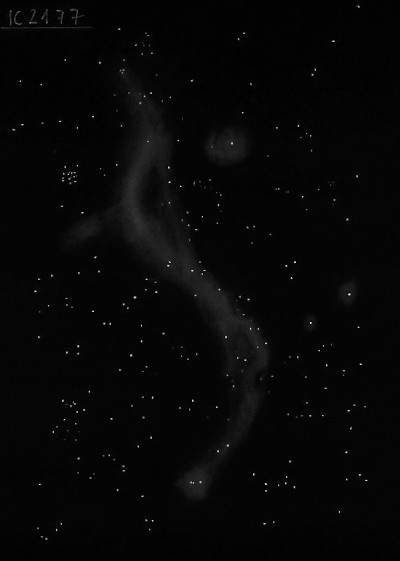
Off the south side is the smaller nebula Ced 90. At 64x it appeared as a faint, round, 3' haze surrounding a mag 8.5 star. Two mag 10.5 stars are collinear off the east side, 2.5' and 3.3' from the center and several mag 12 stars are involved at the south edge. The H-beta filter noticeably improves the contrast and makes the nebulosity a moderately bright, direct-vision object. With averted vision the glow increases to 4'-5' in diameter with some very faint haze extending east. The star density drops off immediately to the west, except for a few stars. Ced 90 is located at the extreme southern tip of the 2.5 degree giant emission nebula IC 2177, which extends north into Monoceros. This is one of a select group of low-excitation nebulae that can be added to the list of H-beta objects.
Isaac Roberts discovered IC 2177 photographically in 1898 surrounding mag 7.3 BD-10 1848. His position (for the mag 7 star) and dimensions of 13' corresponds with the position of vdB 93 = Gum 1 = Sh 2-292, not the 2° N-S strip of nebulosity that is commonly identified as IC 2177 in modern catalogues! The often photographed strip was discovered by Max Wolf in 1905. See Corwin's comments for the full story!
It was also found on a photograph taken on 1 Apr 1911 by Harry Wood at the Transvaal (Union) Observatory with the 10-inch Franklin-Adams camera. Woods described it as a "large faint straggling region, about 2 1/2° long." He added "BD -10° 1848 is involved in a bright patch of nebulosity, in which there are two large holes on the S side of the star." This description refers to Gum 1 (photographed by Roberts). He also noted "BD -12° 1771 is a nebulous star with an extension of the nebulosity on the Nf side; it looks like a comet." This description refers to Sh 2-297 at the southern end of the region.
300/350mm - 13.1" (1/19/85): at 62x and UHC filter appears as a very large, very elongated strip of nebulosity. At the north end is the open cluster NGC 2335 within Monoceros. The southern portion is difficult to trace; it crosses into Canis Major and ends at an easily visible reflection nebula = Ced 90 surrounding a mag 8 star. Also includes nebula NGC 2327 midway along the length. This emission/reflection nebula is referred to as the Eagle or Seagull Nebula.
400/500mm - 17.5" (2/2/02): On the NW side is a circular nebulosity (the head of the Seagull) catalogued as Gum 1 = vdB 93 = Sh 2-292. At 100x it appeared as a very large, circular glow perhaps 15' in diameter of low surface brightness surrounding mag 7.1 V750 Mon with vague hints of structure. The OIII filter gave only a very weak enhancement, but the H-beta filter noticeably improved the contrast at low power. This combination HII/reflection nebula is situated off the NW end of the huge winding IC 2177 strip that extends mostly to the south, and is a wonderfully rich region of the Milky Way with a number of clusters and star groups in the vicinity.
Notes by Steve Gottlieb